
ATTENTION: The works hosted here are being migrated to a new repository that will consolidate resources, improve discoverability, and better show UTA's research impact on the global community. We will update authors as the migration progresses. Please see MavMatrix for more information.
Show simple item record
| dc.contributor.advisor | Lopez, Ramon E. | |
| dc.creator | Bonde, Richard E. F. | |
| dc.date.accessioned | 2018-06-05T18:04:02Z | |
| dc.date.available | 2018-06-05T18:04:02Z | |
| dc.date.created | 2018-05 | |
| dc.date.issued | 2018-05-14 | |
| dc.date.submitted | May 2018 | |
| dc.identifier.uri | http://hdl.handle.net/10106/27439 | |
| dc.description.abstract | As the wind from the Sun advances towards Earth, it interacts with Earth’s magnetic field. This solar wind carries with it a magnetic field, called the interplanetary magnetic field (IMF). Energy and momentum are transferred from the solar wind to the geospace environment through two mechanisms: magnetic reconnection between the IMF and Earth’s magnetic field and a viscous-like interaction. While magnetic reconnection is the dominant mechanism, there are times when the viscous interaction has a significant contribution. Previous studies using magnetohydrodynamic (MHD) simulations to study the viscous interaction have done so using steady state solar wind conditions. The solar wind is highly dynamic and can have considerable changes on the order of minutes. We use the Lyon-Fedder-Mobarry global MHD simulation to test the effect the viscous interaction has on the transpolar potential (TPP) with solar wind velocity fluctuations. The TPP is used as a proxy for the amount of coupling between the solar wind and Earth’s magnetosphere. While fluctuations in the equatorial plane seem to have little or no effect on the TPP, fluctuations in the meridional plane cause variations in the TPP, even creating an asymmetry between the hemispheres. The response the TPP was proportional to the amplitude of the velocity oscillation but appears not to be affected by the frequency of oscillation. There is also a strong flow asymmetry in the magnetotail, which is flapping like a wind sock, in response to these solar wind variations. This creates a large sunward flow in one of the two tail lobes. The effect of solar wind fluctuations can also be tested on the response to the dayside magnetopause. The dayside magnetopause position, regarded as a critical space weather metric, is of great importance to satellite operators. Large-scale fluctuations in the solar wind can compress the magnetopause inward over satellites, exposing them to the hazardous conditions in the magnetosheath. Again, previous studies on the magnetopause position were conducted with steady state solar wind conditions. We ran LFM to gauge the response of the subsolar magnetopause during conditions similar to a high-speed stream (HSS), where there are large Alfvénic fluctuations and the dynamic pressure is relatively constant. The dayside magnetopause responds to these IMF variations in a type of “breathing” mode. The subsolar magnetopause exhibits a hysteresis-like effect, having a roughly constant response time to an IMF perturbation with constantly changing IMF conditions. In certain situations, the subsolar magnetopause position never relaxes to steady state values. This shows that when running MHD simulations, the time history of the solar wind must be taken into account. A HSS from 14-19 September, 2017 was simulated in LFM to see the response of the dayside magnetopause. To verify the actual position of the dayside magnetopause during this event, a series of THEMIS magnetopause crossings were used. The THEMIS crossings, along with the LFM results, were compared to empirical models of the magnetopause. These empirical models use instantaneous solar wind parameters to predict the position of the magnetopause and at times were predicted to over 1 RE from the actual magnetopause position. The work presented in this dissertation shows that to improve the accuracy of empirical models, the time history of the solar wind cannot be overlooked. | |
| dc.format.mimetype | application/pdf | |
| dc.language.iso | en_US | |
| dc.subject | Magnetosphere | |
| dc.subject | Solar wind | |
| dc.title | A STUDY OF THE GEOSPACE RESPONSE TO DYNAMIC SOLAR WIND USING THE LYON-FEDDER-MOBARRY GLOBAL MHD SIMULATION | |
| dc.type | Thesis | |
| dc.degree.department | Physics | |
| dc.degree.name | Doctor of Philosophy in Physics and Applied Physics | |
| dc.date.updated | 2018-06-05T18:06:10Z | |
| thesis.degree.department | Physics | |
| thesis.degree.grantor | The University of Texas at Arlington | |
| thesis.degree.level | Doctoral | |
| thesis.degree.name | Doctor of Philosophy in Physics and Applied Physics | |
| dc.type.material | text | |
| dc.creator.orcid | 0000-0002-8161-5650 | |
Files in this item
- Name:
- BONDE-DISSERTATION-2018.pdf
- Size:
- 7.905Mb
- Format:
- PDF
This item appears in the following Collection(s)
Show simple item record


